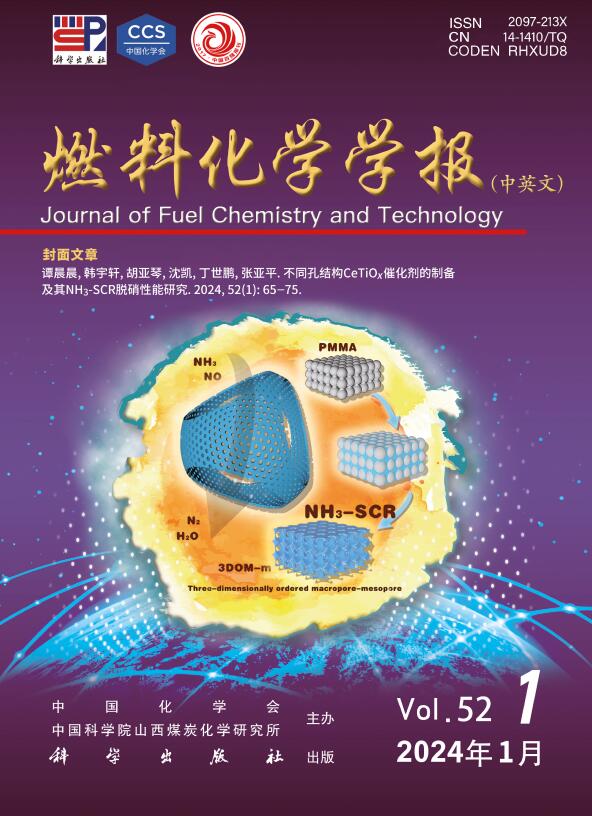粘结剂沥青的制备及其焦化性能:改性方法的影响
Q3 Energy
引用次数: 0
摘要
粘结剂沥青是生产碳/石墨电极和锂离子电池阳极的重要原料。碳/石墨制品的质量和应用在很大程度上取决于粘结剂沥青的性能。高质量的粘结剂间距对提高碳/石墨材料的质量起着关键作用。本研究以精制中沥青为原料。考察了不同改性方法对粘结剂沥青的分子结构、热稳定性和光学微观结构等性能的影响,以及沥青焦的焦化性能,包括沥青焦的光学微观结构、碳微晶结构和碳表面形貌。结果表明,采用两步氧化聚合和温和热聚合法制备了高质量的各向同性粘结剂沥青(软化点144℃,QI含量0.46%,TI含量26.74%,焦化值51.53%,挥发物56.65%)。第一步,精制沥青在280℃下氧化3h;第二步,快速加热到360°C,在氮气气氛下保存1小时。该工艺制得芳香缩合度高、小分子支化结构少的粘结剂沥青。通过热转化和炭化制备的粘结剂沥青焦的光学显微结构由83.92%的单叶和纤维结构组成。粘结剂沥青焦的无序程度较低,形成了规则有序的微晶结构。碳微晶含量呈现出高度的规律性,达到90.89%,而理想的石墨微晶含量IG/IAll为18%。本文章由计算机程序翻译,如有差异,请以英文原文为准。
Preparation and coking property of binder pitch: Effects of modification methods
Binder pitch is a crucial raw material for producing carbon/graphite electrodes and lithium-ion battery anodes. The quality and application of carbon/graphite products largely depend on properties of the binder pitch. High-quality binder pitch plays a key role in enhancing quality of the carbon/graphite materials. In this work, refined medium pitch was used as the raw material. Effect of various modification methods on properties of the binder pitch was examined, such as molecular structure, thermal stability, and optical microstructure, along with its coking properties including optical microstructure of pitch coke, carbon microcrystalline structure, and carbon surface morphology. The results indicate that a high-quality isotropic binder pitch (softening point: 144 °C, QI content: 0.46%, TI content: 26.74%, coking value: 51.53%, volatile matter: 56.65%) was achieved using a two-step oxidation polymerization and mild thermal polymerization method. In the first step, the refined pitch was oxidized at 280 °C for 3 h; in the second, it was rapidly heated to 360 °C and held for 1 h under nitrogen atmosphere. This process produced a binder pitch with a high degree of aromatic condensation and fewer small-molecule branched structures. Optical microstructure of the binder pitch coke, produced through thermal conversion and carbonization, comprised 83.92% leaflet and fibrous structures. Degree of disorder in the binder pitch coke was relatively low, resulting in a regular and orderly microcrystalline structure. The content of carbon microcrystals exhibited a high degree of regularity, reaching 90.89%, while the ideal graphite microcrystal content IG/IAll was 18%.
求助全文
通过发布文献求助,成功后即可免费获取论文全文。
去求助
来源期刊

燃料化学学报
Chemical Engineering-Chemical Engineering (all)
CiteScore
2.80
自引率
0.00%
发文量
5825
期刊介绍:
Journal of Fuel Chemistry and Technology (Ranliao Huaxue Xuebao) is a Chinese Academy of Sciences(CAS) journal started in 1956, sponsored by the Chinese Chemical Society and the Institute of Coal Chemistry, Chinese Academy of Sciences(CAS). The journal is published bimonthly by Science Press in China and widely distributed in about 20 countries. Journal of Fuel Chemistry and Technology publishes reports of both basic and applied research in the chemistry and chemical engineering of many energy sources, including that involved in the nature, processing and utilization of coal, petroleum, oil shale, natural gas, biomass and synfuels, as well as related subjects of increasing interest such as C1 chemistry, pollutions control and new catalytic materials. Types of publications include original research articles, short communications, research notes and reviews. Both domestic and international contributors are welcome. Manuscripts written in Chinese or English will be accepted. Additional English titles, abstracts and key words should be included in Chinese manuscripts. All manuscripts are subject to critical review by the editorial committee, which is composed of about 10 foreign and 50 Chinese experts in fuel science. Journal of Fuel Chemistry and Technology has been a source of primary research work in fuel chemistry as a Chinese core scientific periodical.
 求助内容:
求助内容: 应助结果提醒方式:
应助结果提醒方式:


